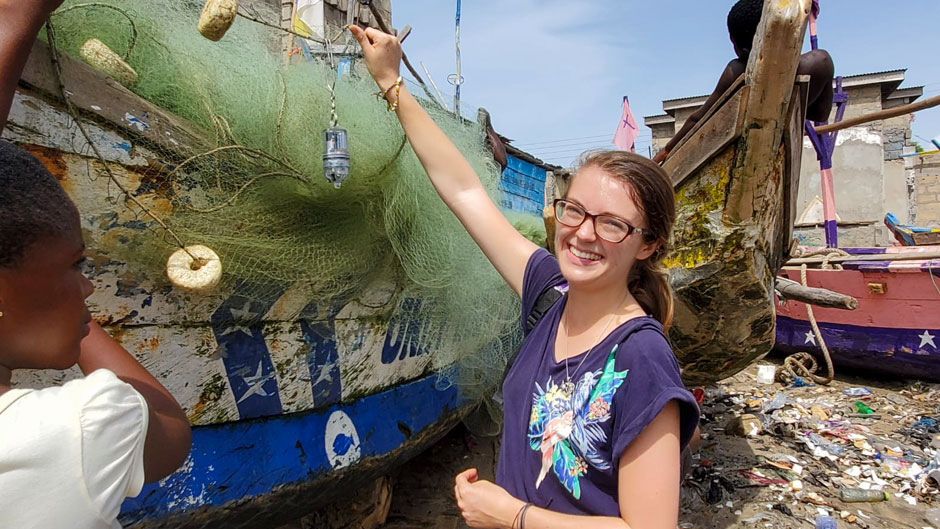The most ancient, and largest sea turtles in the ocean spend a majority of their lives flying through the water, all while helping to control jellyfish populations and preserving the ecological balance of the sea.
But despite their serene demeanor, the leatherback sea turtles are struggling to survive.
This is particularly true off the coasts of South America, where fishermen catch them accidentally in gillnets, a potentially fatal encounter for these sea turtles. Research in Ecuador and Peru reveals that about 35 percent of all sea turtles caught in these nets will die in them. And although this is perilous for all sea turtles, the critically endangered leatherbacks are faring the worst. Populations that spend their lives in the eastern Pacific Ocean, foraging off the coast of Peru, Ecuador, and Chile, have experienced a 98 percent decline in the past 30 to 40 years, reports indicate.
Leyna Stemle, a University of Miami graduate biology student, wanted to find a way to help conserve these vulnerable leatherback populations. So, with the help of a U.S. Fulbright grant, she was able to connect with Phil Allman, a biology professor at Florida Gulf Coast University, who has been studying the threats against these reptiles for years and began investigating an innovative and novel approach using light sources in 2015.
Stemle spent nine months living in Winneba, Ghana, a fishing village where these unique sea turtles are prevalent and often nest on the beaches. There, Stemle assisted in gathering additional data to the multi-year study started by Allman and Ph.D. student Andrews Agyekumhene at the University of Ghana, to test a theory that had been helpful for other sea turtles but had never been tested with leatherbacks. If fisherman attached floating green LED lights to the top of their nets, would it prevent the sea turtles from swimming into these dangerous traps?
First, Allman and Agyekumhene completed a 10-month study on the lights in Mankoadze, Ghana. After promising results, Stemle joined the team in further testing the lights in Winneba. After eight months of testing, the team found some overwhelming results—the boats with illuminated nets reduced the number of entangled sea turtles by 81 percent. In addition to leatherback turtles, the study found that the lights also reduced the number of olive ridley and green sea turtles caught in the nets. And the lights also did not affect the quantity of fish the boats were able to catch, so fisherman could be willing to use them, Stemle said.
“I hope that we can use this technology to reduce the number of sea turtles caught in nets, so that hopefully we will see some implementation of these lights in Ghana and on the eastern Pacific coast, like in Ecuador, Peru and Chile,” said Stemle. “Particularly for the leatherbacks, we are running out of time.”
Scientists believe that sea turtles are able to see or sense the wavelength of light present in the small green LED bulbs, and that its presence either deters them from the nets or helps them see the nets and swim away from them.
Although gillnets are destructive to the ocean floor and are no longer legal in most places in the United States, the nets—which are dropped in the water and then retrieved a few hours later—are used widely in places like West Africa and South America where fishing is a critical part of the economy.
While Stemle completed her research on the Fulbright research grant before starting her Ph.D. at the University of Miami, she continues to keep in touch with Allman and the other researchers and hopes to return to Africa to implement the lights system in other fishing villages.
She is also in touch with leaders from The Leatherback Project, a conservation group working with the Ecuadorian government to protect this unique sea turtle species. Callie Veelenturf, founder and director of The Leatherback Project, said that about 46,500 sea turtles are caught in fishing nets each year in Peru, Ecuador, and Chile, and the majority of them—87 percent—are entangled just off the coast of Ecuador. The group is now planning its own six-month pilot project to test the lights on artisanal fishing boats that operate from Ecuador.
Stemle hopes that the work she collaborated on can be used to help save the sea turtles, which face multiple threats to their survival and reproduction, such as pollution and climate change, in addition to the top international threat—fisheries bycatch.
“I am excited to see how much of an impact this could have on sea turtle preservation and conservation, and I’m glad we were able to do some projects that are applicable to other parts of the world where leatherbacks are disappearing quickly,” Stemle said.

